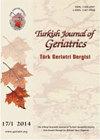PROGNOSIS AND RISK FACTORS FOR GERIATRIC STROKE PATIENTS IN EACH DECADE
IF 0.3
4区 医学
Q4 GERIATRICS & GERONTOLOGY
Turkish Journal of Geriatrics-Turk Geriatri Dergisi
Pub Date : 2023-01-01
DOI:10.29400/tjgeri.2023.355
引用次数: 0
Abstract
Introduction: We aimed to compare the demographic characteristics, stroke localizations, stroke risk factors, and prognoses of geriatric stroke patients in different age groups. Materials and Methods: Geriatric patients who had a neurological consultation following an acute ischemic stroke were evaluated in the study. Patients were divided into age groups of 65–69, 70–79, 80–89, and 90 years and older. The demographic findings, the diseases of the patients, pre-stroke antiaggregant or anticoagulant treatment, previous history of cerebrovascular disease, presence of atrial fibrillation, laboratory data, imaging reports from initial presentation, Echocardiography and Carotid-Vertebral Doppler Ultrasonography results were recorded. Neurological deficits were evaluated using the National Institutes of Health Stroke Scale and the Modified Rankin Score. Results: The study evaluated 298 patients (161 females, 137 males). Significant differences were found in all four age groups in terms of the presence of diabetes mellitus. In relation to infarct localization, there were no significant differences between the four age groups. Previous antiaggregant or anticoagulant treatments were similar in all age groups. There were significant differences between the groups in terms of the presence of atrial fibrillation at presentation. In the 90 years and over age group, the values for the National Institutes of Health Stroke Scale and Modified Rankin Score were significantly higher. Conclusion: The incidence of stroke can be reduced by the regular evaluation of elderly individuals for modifiable risk factors and their management. In elderly individuals who had ischemic strokes, we recommend to comprehensive cardiac assessment, including procedures like a 24-hour Holter monitor and transesophageal echocardiography for cardioembolic origins. Keywords: Stroke; Geriatric; Risk factors; Prognosis.每十年老年脑卒中患者预后及危险因素分析
前言:我们的目的是比较不同年龄组老年脑卒中患者的人口学特征、脑卒中定位、脑卒中危险因素和预后。材料和方法:在研究中评估了急性缺血性卒中后进行神经学咨询的老年患者。患者分为65-69岁、70-79岁、80-89岁和90岁及以上年龄组。记录人口学调查结果、患者的疾病、卒中前抗凝或抗凝治疗、既往脑血管病史、房颤的存在、实验室数据、首发影像报告、超声心动图和颈椎多普勒超声结果。神经功能缺损采用美国国立卫生研究院卒中量表和修正兰金评分进行评估。结果:共纳入298例患者,其中女性161例,男性137例。在所有四个年龄组中,糖尿病的发生率均有显著差异。在梗死定位方面,四个年龄组之间没有显著差异。所有年龄组以前的抗凝或抗凝治疗相似。在房颤的出现方面,两组之间存在显著差异。在90岁及以上年龄组中,美国国立卫生研究院卒中量表和修正Rankin评分的数值显著较高。结论:定期对老年人可改变的危险因素进行评估和管理,可降低脑卒中的发生率。对于患有缺血性中风的老年人,我们建议进行全面的心脏评估,包括24小时动态心电图监测和经食管超声心动图检查心脏栓塞源。关键词:中风;老年;风险因素;预后。
本文章由计算机程序翻译,如有差异,请以英文原文为准。
求助全文
约1分钟内获得全文
求助全文
来源期刊

Turkish Journal of Geriatrics-Turk Geriatri Dergisi
GERIATRICS & GERONTOLOGY-
CiteScore
0.60
自引率
0.00%
发文量
46
审稿时长
6-12 weeks
期刊介绍:
Turkish Journal of Geriatrics is a peer-reviewed journal. Official language of the journal is English. Turkish Journal of Geriatrics invites submission of Original Articles based on clinical and laboratory studies. Review Articles are published only after the invitation from the Editorial Board.
 求助内容:
求助内容: 应助结果提醒方式:
应助结果提醒方式:


